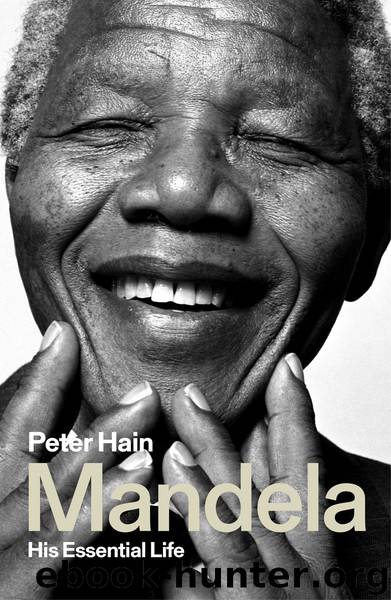Mandela by Peter Hain

Author:Peter Hain
Language: eng
Format: epub
ISBN: 9781786607591
Publisher: Rowman & Littlefield International
Footnote
*Then aged fifteen, I read the address at his funeral in my school uniform after my father (subject to a banning order) had been prevented from doing so.
• 6 •
Resistance
As the intolerable treatment of Winnie Mandela confirmed, the apartheid superstructure and its feared security apparatus remained firmly in place. With Nelson Mandela and his Rivonia comrades entering their second decade on the island, white South Africa had been enjoying a better international press than usual in the two years to mid-1976, as so-called petty apartheid was ameliorated. Whites-only signs were reported being removed from some park benches; black athletes were pictured competing against whites on select occasions to try to break through the strong solid sports boycott; and John Vorster, the prime minister, was courted as peace-maker in the Rhodesian deadlock. Apartheid’s propaganda machine had reason to be pleased with itself.
Suddenly that illusion was shattered by a six-letter word: Soweto. Now a complex of twenty-eight townships including Orlando, where the Mandelas had their small home, Soweto had no electricity, no proper shops and no modern amenities—just vast numbers of boxlike concrete houses with water and drainage; the official population of six hundred thousand had risen to be well over a million.
On the morning of June 16, 1976, white policemen fired on schoolchildren protesting peacefully against an edict the previous year forcing them to be taught in Afrikaans. They had been carrying placards with slogans such as “Down with Afrikaans”, “Blacks Are Not Dustbins”, “Afrikaans Stinks”, “Afrikaans Is Tribal Language” and “Bantu Education—To Hell with It.”
The first child to be killed was thirteen-year-old Hector Pietersen, whose photograph was flashed around the world as he died being carried by his crying brother. The township exploded—police vehicles were stoned and set on fire, police dogs unleashed upon students were knifed, official buildings and vehicles were burned and looted and two white officials were killed. A storm of resistance was unleashed, with Soweto in the middle and virtually under martial law as an occupied territory. On four days in August, the students organized work boycotts—stay-at-homes—by Soweto workers, which seriously crippled business in Johannesburg. Shock waves tore through the country as black communities took to the streets in a display of defiance at the hated white oppression greater even than that which followed the Sharpeville massacre sixteen years before. It met with a predictable response: protesters shot down mercilessly, in the back, the head and the chest. By the end of the year, more than six hundred were dead and over six thousand had been arrested.
Although the hated Afrikaans decree was withdrawn, many pupils fled to escape the police. Apartheid-sponsored administrative bodies in Soweto collapsed amid the agitation organized by the now-powerful Soweto Students Representative Council, and a new movement of Black Consciousness organizations developed, with a new generation of activists and militants. Then, on September 12, 1977, there was further outrage when their leader, Steve Biko, died in police custody in Pretoria. He had suffered brain damage from a police beating in a cell
Download
This site does not store any files on its server. We only index and link to content provided by other sites. Please contact the content providers to delete copyright contents if any and email us, we'll remove relevant links or contents immediately.
| Africa | Americas |
| Arctic & Antarctica | Asia |
| Australia & Oceania | Europe |
| Middle East | Russia |
| United States | World |
| Ancient Civilizations | Military |
| Historical Study & Educational Resources |
Goodbye Paradise(3462)
Men at Arms by Terry Pratchett(2686)
Tobruk by Peter Fitzsimons(2380)
Arabs by Eugene Rogan(2198)
Pirate Alley by Terry McKnight(2132)
Borders by unknow(2122)
Belonging by Unknown(1736)
It's Our Turn to Eat by Michela Wrong(1596)
The Biafra Story by Frederick Forsyth(1564)
Botswana--Culture Smart! by Michael Main(1487)
The Source by James A. Michener(1460)
A Winter in Arabia by Freya Stark(1449)
Gandhi by Ramachandra Guha(1437)
Coffee: From Bean to Barista by Robert W. Thurston(1422)
Livingstone by Tim Jeal(1396)
The Falls by Unknown(1374)
The Shield and The Sword by Ernle Bradford(1316)
Africa: Altered States, Ordinary Miracles by Richard Dowden(1296)
Egyptian Mythology A Fascinating Guide to Understanding the Gods, Goddesses, Monsters, and Mortals (Greek Mythology - Norse Mythology - Egyptian Mythology) by Matt Clayton(1279)
